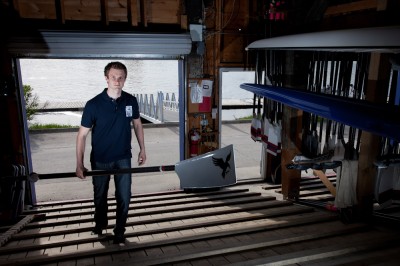(Ottawa) – How will you spend your summer? Chances are, it won’t be what PhD biology student Richard Webster is doing. He’ll be participating in an expedition rowing to the Magnetic North Pole (MNP), the first time this has been attempted.
Webster is the science officer for the team. He will be stationed in Resolute Bay, Nunavut, for 30 days while his teammates row 724 kilometres from Resolute to their final destination. He is also the first reserve, so if one of the rowers is injured, he will be helicoptered in as a replacement.
The trip is not just an adventure; the team wants to draw attention to the dramatic impact of climate change on the North. “It’s completely mind-blowing to think it is possible to hop on a boat and cruise to the MNP,” remarks Webster. “Where is all that ice? This extreme polar ocean row should make people sit up and think about the changing Arctic.”
Once the rowers depart on approximately Aug. 1, Webster and another person will be touchstones for the team, offering regular weather updates that could be critical to the crew, while acting as point persons onsite to help update the world about their progress. They will also conduct science research to test the salinity of water samples gathered by the team. “If it’s low, that means there has been a lot of ice melt,” explains Webster.
“I wanted to do this because I will be marrying my passions – science, environmental conservation and rowing,” says Webster. He also admits that he is attracted to extreme events, having already participated in expeditions to Kenya and competed in the half Ironman competition.
Webster is pursuing his doctorate under the supervision of Biology professors Tom Sherratt and Jean-Guy Godin. “Richard has shown boundless energy and passion for his research on how insects camouflage themselves from predators,” says Sherratt. “We know he will bring this same enthusiasm to this Arctic adventure, while helping to highlight an important global issue.”
The trek is the brainchild of adventurer Jock Wishart, who is the only person to have walked unsupported to a Pole and rowed across an ocean.
Webster applied over a year ago when he heard that Wishart was looking for people like explorer Ernest Shackleton’s original Antarctic crew: “Men wanted for hazardous journey. Small wages, bitter cold, long months of complete darkness, constant danger, safe return doubtful, honour and recognition in case of success.”
Wishart says Webster is “a good oarsman and outdoors man and never takes ‘No’ for an answer. Extremely committed, his scientific background and specific knowledge of Canadian issues makes him ideal for the appointment as Scientific Officer.”
Webster was thrilled to find out that he had beat out almost 300 other people to win a spot on the team. Since that time, he has been doing daily training, often working out with the Carleton University rowing team, having been a former member.
The “Old Pulteney Row to the Pole” is sponsored by the Old Pulteney distillery. You can follow the progress of the expedition at this site: http://www.rowtothepole.com/the-diary/.
The North Magnetic Pole is the point at which the Earth’s magnetic field points vertically downwards. The first expedition to reach the MNP was led by James Clark Ross, who found it at Cape Adelaide on the Boothia Peninsula on June 1, 1831. But the MNP actually moves. Today, it is located at 78°35.7N 104°11.9W / 78.595°N 104.1983°W.
-30-
For more information:
Lin Moody
Media Relations, Carleton University
613-520-2600, ext. 8705
lin_moody@carleton.ca
Tuesday, July 5, 2011 in Grad Student Research, News
Share: Twitter, Facebook





